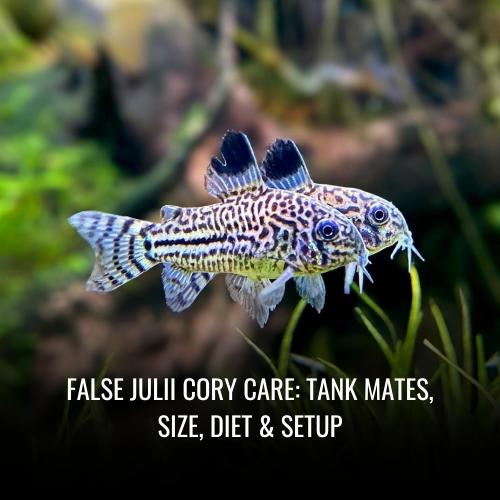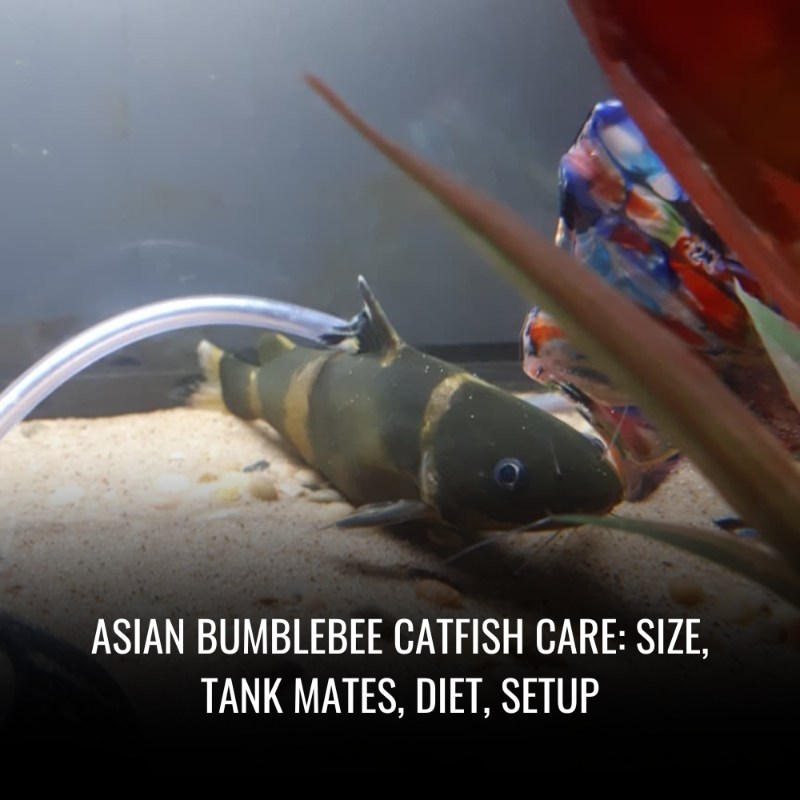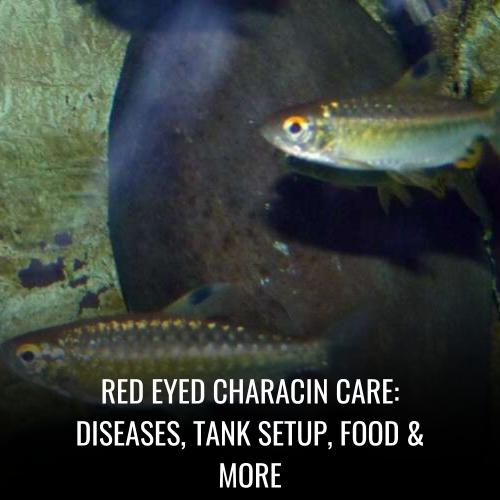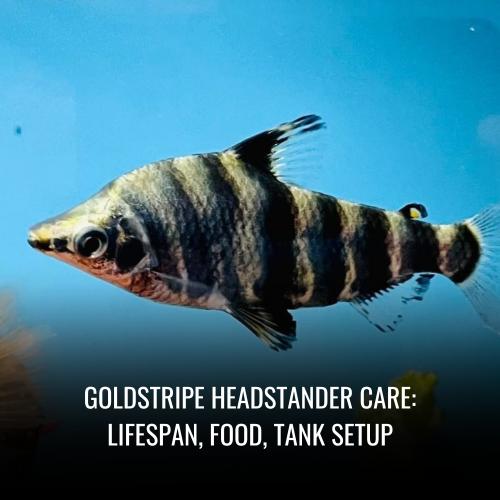Spotted ctenopoma Care: tank mates, Diseases, Food
This post contains affiliate links. As an Amazon Associate, we earn from qualifying purchases.
The Spotted Ctenopoma, or the Leopard Ctenopoma, is a medium-sized gourami species renowned for its eye-catching pattern. This fish exhibits nocturnal behavior, moving cautiously and capable of capturing prey by protruding its mouth for ambush. It possesses protective spines on its gill covers and dorsal fin, with males showing more prominent features.
Closely resembling its relatives, the Climbing Gouramies, the Spotted Ctenopoma is a labyrinth fish boasting a unique leaf-like appearance and adaptability. Native to Africa, particularly the Leopard Bush fish’s territory, the species is known for its curiosity in home aquariums. It has a varied diet that can include brine shrimp, proving to be a fascinating addition to a community tank with appropriate tank mates like the Silver Dollar and Bala Shark.
Spotted Ctenopoma Characteristics:
| Characteristic | Detail |
|---|---|
| Scientific Name | Ctenopoma acutirostre |
| Family | Anabantidae |
| Usual Tank Size | 60 gallons (227 liters) |
| pH Range | 6.0 – 8.0 |
| Water Hardness (dGH) | 5-19 |
| Temperature | 22.0 to 26.0°C (72 to 79°F) |
| Reproduction | Egg layer |
| Origin | Africa |
| Temperament | Peaceful to own species, Predatory |
| Placement in Tank | Mid-level to top |
| Lifespan | 1.4 – 4.4 years |
| Filtration System | Moderate to strong |
| Sexual Dimorphism | Males have more gill cover spines |
| Substrate Cleaning | Not required |
This exotic species requires a minimum population to ensure genetic diversity and thrives in a well-maintained environment, displaying all the wonder of its natural Phylogenetic diversity. Its lifespan and care make it a worthy subject of special reports and fish series, cited by multiple internet sources.
Scientific Name
The Spotted Ctenopoma, with its distinct pointed snout and comb-like scale arrangement, is aptly categorized under the scientific name Ctenopoma acutirostre. “Ctenopoma” originates from Greek roots: “cteno” meaning ‘comb’ and “poma” referring to ‘cover’. This nomenclature reflects the species’ unique scaled texture that mimics the appearance of a comb.
Renowned in the aquarium world as the Leopard Ctenopoma, its scientific name is a critical tool used by aquarists and biologists alike. This designation ensures accurate communication about the species, as it relates to its evolutionary and biological links. Here is a breakdown of its taxonomy:
| Taxonomic Classification | Detail |
|---|---|
| Genus | Ctenopoma |
| Species | acutirostre |
| Common Name | Leopard Ctenopoma |
The scientific name underscores not only the fish’s physical traits but also its placement within the complex web of aquatic life.
Average Size
The Leopard Bush Fish, or Spotted Ctenopoma, is a fish species that exhibits a considerable difference in size between individuals in the wild and those kept in home aquariums. Wild specimens typically grow larger, with an average adult size reaching up to 20 centimeters (8 inches), reflecting their natural propensity for spacious habitats and abundant resources.
Awareness of the maximum size this exotic fish can attain is essential for responsible aquarists. Providing a suitable home for Leopard Ctenopoma requires a commitment to a long-term care plan that accounts for their slow growth and ultimate size. Each aquarist must ensure enough space and proper conditions for these unique fish to flourish over time. For a succinct overview of the species’ average size, see the table below:
| Habitat | Average Adult Size |
|---|---|
| Wild | 20 cm (8 inches) |
| Captivity | 15 cm (6 inches) |
By understanding the growth expectations of Leopard Ctenopoma, aquarium enthusiasts can create a more harmonious and sustainable environment for these captivating inhabitants.
Lifespan
In a nurturing aquarium setup, the Spotted Ctenopoma, often referred to as Leopard Ctenopoma or Leopard Bush Fish, can enjoy a rewarding lifespan ranging from 5 to 8 years. Their longevity is greatly influenced by the level of care they receive. An optimal diet and ideal tank conditions play a pivotal role in the vitality and lifespan of these curious fish.
It is incumbent upon owners to cultivate a conducive habitat that echoes the species’ natural environment to support their typical life cycle in captivity. Below is a quick reference table summarizing care factors that affect the lifespan of Spotted Ctenopoma:
| Care Factor | Influence on Lifespan |
|---|---|
| Balanced Diet | Critical |
| Water Quality | Paramount |
| Tank Maintenance | Essential |
| Stress-Free Setting | Crucial |
| Tank Mates Compatibility | Important |
By adhering to these aspects of aquarium care, enthusiasts can ensure their Spotted Ctenopomas lead a full and healthy life.
Natural Habitat
The Spotted Ctenopoma, distinctively known as the leopard bush fish, thrives in the diverse ecosystems of the Congo River basin in Middle Africa. Across this vast expanse, the species displays remarkable adaptability to a wide array of aquatic landscapes, from the brisk currents of swiftly running streams to the stillness of quiet ponds.
This sheltering flora and fauna not only serve as a reprieve from predators but also as a strategic advantage for the ambush predators that Spotted Ctenopoma are.
The table below highlights the key features of the Spotted Ctenopoma’s natural habitat:
| Natural Feature | Benefit to Spotted Ctenopoma |
|---|---|
| Aquatic Plants | Hiding and hunting grounds |
| Fallen Branches | Shelter and camouflage |
| Submerged Roots | Protection and ambush spots |
| Varied Water Quality | Adaptability to environment |
| Biotopes Range | Broad ecological tolerance |
This dynamic habitat is a testament to the versatility and robust nature of the Spotted Ctenopoma, contributing to both their survival and ecological success.
Appearance
With a visual allure par excellence, the Spotted Ctenopoma, or leopard climbing perch, delights the observer with its remarkable pattern of brown, black, and occasional hues of red or orange spots. These spots mimic the iconic markings of a leopard and give the fish an exotic and dramatic flair perfect for the home aquarium.
This eye-catching pattern is more than just ornamental; it serves as an efficient camouflage, enabling the Spotted Ctenopoma to merge with its surroundings seamlessly. Their natural curiosity is evident as they navigate the aquarium, smoothly gliding through the water to investigate every potential hideout or point of interest.
| Key Physical Feature | Description |
|---|---|
| Body Shape | Elongated with an arched back |
| Fins | Long and flowing |
| Eyes | Large and expressive |
| Color Pattern | Spots in shades of brown, black, red, or orange |
Their unmistakable appearance and inquisitive behavior make Spotted Ctenopoma a captivating addition to any aquatic community.
Behavior & Temperament
Spotted Ctenopoma, also known by the more exotic moniker of leopard bush fish, are fascinating aquatic creatures admired for their unique behavior and temperament. Although they are considered predatory, their calm and peaceful demeanor makes them excellent inhabitants of community tanks, provided they are housed with non-aggressive fish species.

Are Spotted Ctenopoma Fin Nippers?
One widely appreciated characteristic of the Spotted Ctenopoma is that they are not known to be fin nippers. Their peaceful approach towards other tank mates, large enough to be out of their dietary consideration, ensures a safe environment for a variety of fish species. As ambush predators, they rely more on a surprise tactic, using their sizable mouths to engulf their prey rather than showing any propensity for fin-nipping.
Are Spotted Ctenopoma Aggressive To Each Other & Other Fish?
When considering the Spotted Ctenopoma’s interactions with conspecifics and other tank inhabitants, they are generally regarded as non-aggressive. However, like many fish species, they may show territorial behavior, which is often mitigated by providing ample space and hiding spots within the aquarium. It’s noteworthy to mention that these leaf fish can exhibit aggressive tendencies during breeding and would benefit from a separate breeding tank to avoid conflict.
Are Spotted Ctenopoma Friendly To Each Other & Other Fish?
The Spotted Ctenopoma’s shy yet inquisitive nature fosters a friendly predisposition towards fellow tank dwellers, making them a harmonious addition to a community tank. They often exhibit a cooperative spirit, especially when provided with a well-structured habitat that includes plant cover and ornaments, which are crucial for their sense of security. This setup encourages more open and active engagement from these curious fish.
Are Spotted Ctenopoma Schooling Fish?
In contrast to common schooling fish, Spotted Ctenopoma are inherently solitary creatures. They do not require the presence of their species for social engagement or well-being. Nevertheless, they may display an increase in confidence and security when housed in groups, particularly in larger tanks with numerous hiding places that cater to their territorial inclinations.
Can You Have Just One Spotted Ctenopoma In The Tank?
Certainly, maintaining a single Spotted Ctenopoma in an aquarium is not only feasible but often beneficial. This arrangement allows individual fish to claim their territory without the stress of competition, embracing their natural solitary behavior. Furthermore, a lone Spotted Ctenopoma has the opportunity to become the centerpiece of the tank, intriguing onlookers with its behavior and interaction with the environment.
Do Spotted Ctenopoma Need To Be In Groups?
While Spotted Ctenopoma does not necessitate group living, doing so can reflect a more naturalistic setting that encourages social behaviors akin to those observed in their wild habitats within the Congo River basin. Grouped individuals often exhibit a more relaxed demeanor, are visibly more active, and contribute to a dynamic and engaging aquatic display. However, keepers should be attentive to tank size and the individual personalities of their fish to ensure harmonious coexistence.
In conclusion, the Spotted Ctenopoma is a species imbued with a complex and captivating set of behaviors that, when properly accommodated, can thrive in a variety of aquarium settings. They are an exotic and eye-catching addition to the aquatic hobby, with a temperament that often leads them to be cherished by enthusiasts for their peaceful and curious nature.
Food & Diet
Spotted Ctenopoma, with their carnivorous nature, require a specialized diet predominantly consisting of meat. They are known for their prowess as ambush predators, preferring to feast on insects, larvae, and small fish in their natural habitats in Africa.
In captivity, their dietary needs must be met with equivalent vigor. Live foods align most with their natural predilections and can include brine shrimp, tubifex worms, and even mollusks.
In the realm of their dietary habits:
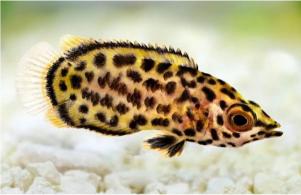
Do Spotted Ctenopoma Eat Algae?
Contrary to popular belief, Spotted Ctenopoma do not typically ingest algae as it doesn’t feature in their primary diet. They are carnivorous and pursue a diet of animal-based food, predominantly in the wild.
Although they may nibble on algae occasionally within the aquarium, this should not be mistaken as a dietary preference or a reliable means to control algae. A balanced diet that includes high-quality pellets, along with live and frozen protein sources, is essential for their well-being.
Do Spotted Ctenopoma Eat Shrimp?
In the aquarium setting, Spotted Ctenopoma might indeed find shrimp an appealing snack, especially if the shrimp are small or of juvenile size. While some robust shrimp species may hold their own against these leaf fish, more diminutive and meek varieties can fall prey.
Therefore, it is wise to consider the size and behavior of shrimp tank mates when housing Spotted Ctenopoma, keeping in mind their predatory nature and diverse diet preferences.
Do Spotted Ctenopoma Eat Bloodworms?
Bloodworms are an integral part of the Spotted Ctenopoma’s diet in captivity, providing them with the necessary protein and nutrients for thriving. Offering bloodworms indulges their hunting instincts and offers mental stimulation. Although it’s acceptable to feed them as a treat, bloodworms alone should not constitute their entire diet—variety is key to their health.
Do Spotted Ctenopoma Eat Mosquito Larvae?
Indeed, Spotted Ctenopoma can contribute to pest control by consuming mosquito larvae. These larvae form part of their diverse dietary intake and satisfy their carnivorous cravings. Absorbing the natural role of a predator, Spotted Ctenopoma in both wild and aquarium environments instinctively prey on and forage for mosquito larvae.
Does Spotted Ctenopoma Eat Planaria?
The sigh of a Spotted Ctenopoma consuming planaria can assure aquarists of their efficient predatory skills. They incorporate planaria into their diets, reflecting their opportunistic feeding behavior. With their adaptable nature, these leaf fish aid in maintaining the ecological balance within the aquarium by controlling planaria populations.
Do Spotted Ctenopoma Eat Plants?
It is unusual for Spotted Ctenopoma to actively seek out or consume plant life within their environment. Their tendency to disturb plants is more so a byproduct of their investigative behavior rather than a dietary choice. While minimal plant nibbling might occur, it is often insignificant and occurs primarily if the fish are not receiving adequate meaty foods.
Sexing: Male vs Female
Determining the sex of a Spotted Ctenopoma can be a subtle and meticulous process, as males and females appear similar in coloration and patterning. The main indicator is the presence of short spines on the gill covers, also known as the operculum, of males. These spines are absent in females, setting the two apart.
Differences:
| Characteristic | Male | Female |
|---|---|---|
| Gill Covers (Operculum) | Short spines present | Spines absent |
| Color & Pattern | No significant difference | No significant difference |
Observing these spines requires a detailed examination, and it is a task better suited for the experienced eye. Additionally, handling Spotted Ctenopoma should be done with care to avoid stress and potential health risks to the fish.
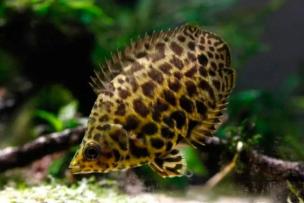
Spotted ctenopoma Tank Mates
When setting up a community tank featuring Spotted Ctenopoma, also known by the enchanting name ‘leopard ctenopoma,’ selecting the right tank mates is crucial to maintaining harmony and balance. These fish are tranquil and mesh well with similarly non-aggressive species. Ideal companions in the aquarium include tetras, rasboras, and peaceful dwarf cichlids, which share a disposition that aligns with their leaf fish cousins.
Recommended Tank Mates for Spotted Ctenopoma
- Mid to Upper Levels:
- Tetras: Congenial and active
- Rasboras: Peace-loving and adaptable
- Peaceful Dwarf Cichlids: Non-confrontational and colorful
- Bottom Levels:
- Corydoras: Gentle and bottom-feeding
- Loaches: Peaceful and bottom-dwelling
Careful selection of tank mates ensures a tranquil community aquarium, allowing the Spotted Ctenopoma to thrive in a serene and secure environment.
Aquarium Setup
Creating the perfect environment for Spotted Ctenopoma, also known as the leopard ctenopoma or climbing perch, involves emulating their natural habitat within the confines of an aquarium. These medium-sized gourami species, natives of the slow-moving waterways of Africa, require a thoughtfully designed space to thrive. This section delves into the essentials of their ideal tank size, water parameters, filtration, and lighting.
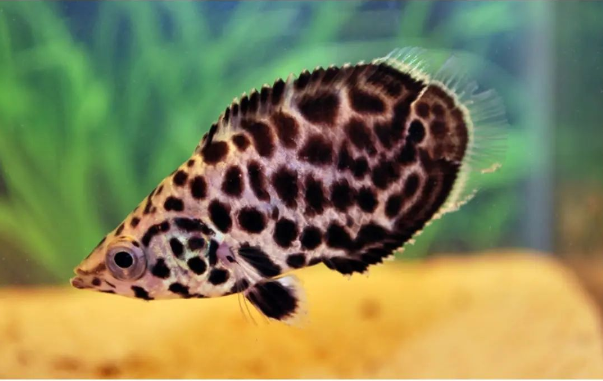
Ideal Tank Size
Spotted Ctenopoma are active and territorial fish that flourish in a spacious environment. A tank measuring a minimum of 90x40x40 cm (approximately 30 gallons) is suitable for a single specimen, providing ample swimming space and allowing for territory establishment.
For hobbyists desiring to maintain a group of these exotic fish, a larger aquarium, with a capacity of 40 to 55 gallons or more, is advisable to reduce conflicts and afford a more authentic replication of their natural surroundings. The tank should be at least 36 inches in length, supporting lateral movement, while a minimum height of 20 inches accommodates their penchant for climbing.
Ideal Water Parameters
The Spotted Ctenopoma’s comfort hinges on specific water conditions that closely resemble African river ecosystems. The preferred pH range is 6.5 to 7.5, ensuring a slightly acidic to neutral environment. These curious fish fare best in warm waters, between 75 to 82 degrees Fahrenheit (24 to 28 degrees Celsius), and require soft to moderately hard water with a dGH of 5 to 15. Consistent water quality is paramount, with regular checks on ammonia, nitrite, and nitrate levels to sustain their health. Furthermore, a serene water flow and sufficient oxygenation reflect their habitat in the wild.
Filtration
For these fish species, proper filtration transcends basic tank maintenance—it’s paramount for their survival. An effective filtration system manages waste and keeps the water clear of debris, which, if left unattended, could raise ammonia and nitrite levels to dangerous heights.
It’s also instrumental in oxygenating the water, an essential for Spotted Ctenopoma’s labyrinth organ, enabling it to breathe atmospheric air. Depending on the tank’s size and the number of inhabitants, a combination of mechanical, biological, and chemical filtration might be necessary to cultivate an immaculate aquatic environment.
Lighting
Spotted Ctenopoma have a propensity for low-light environments, a tribute to their origins in shaded waters. Emulating these conditions can be achieved by using dim or indirect lighting options, such as adaptable LED systems that are both energy-efficient and long-lasting. The inclusion of dense vegetation and floating flora replicates the shady retreats these fish favor.
Extreme lighting conditions are to be avoided as they can cause undue stress and reclusive tendencies. Implementing a timer to regulate the lighting, maintaining predictable daylight and nocturnal cycles, harmonizing their circadian rhythms, and promoting natural behavior and robust vitality.
The summarized table below outlines the ideal conditions for Spotted Ctenopoma based on the facts provided:
| Aspect | Ideal Conditions |
|---|---|
| Tank Size | Minimum 90x40x40 cm (30+ gallons) |
| Water pH | 6.5 to 7.5 |
| Temperature | 75 to 82°F (24 to 28°C) |
| Water Hardness | 5 to 15 dGH |
| Lighting | Subdued, with dense planting/shading |
| Filtration | Effective mechanical, biological, & chemical |
By strictly adhering to these guidelines, aquarists can set the stage for a thriving community tank, where Spotted Ctenopoma and their tank mates coexist harmoniously, exemplifying phylogenetic diversity and natural beauty.
Common Possible Diseases & Prevention
Common Possible Diseases & Prevention Spotted Ctenopoma, with its eye-catching patterns, is not immune to common aquarium ailments like ich, fin rot, and velvet. These diseases are often avoidable with vigilant care and a pristine tank environment. For instance, quarantining newcomers effectively minimizes the risk of pathogenic intrusions into your community tank, ensuring the safety of these leaf fish and their companions.
Food fish like the Spotted Ctenopoma require a diet rich in nutrients. Ensuring a balance between live prey, such as brine shrimp, and quality prepared foods supports their immune function and overall well-being. This nutritional focus is a pivotal factor in fending off diseases related to dietary deficiencies.
Below is a quick reference guide for disease prevention in Spotted Ctenopoma:
| Prevention Tips | Description |
|---|---|
| Quarantine New Fish | Isolates new additions to prevent disease spread. |
| Regular Monitoring | Observes changes in fish behavior and appearance for early detection. |
| Avoid Overcrowding | Reduces stress and bolsters immunity. |
| Maintain Water Quality | Keeps conditions optimal to prevent disease-friendly environments. |
| Balanced Diet | Provides nutritional support for a strong immune system. |
Breeding Spotted Ctenopoma in Aquarium
Breeding the mesmerizing Spotted Ctenopoma in an aquarium setting is an engaging challenge that necessitates replicating their natural spawning conditions. Here’s a concise guide to help enthusiasts foster a suitable breeding environment for these curious fish:
- Create a Conducive Environment: Arrange ample hiding spaces and vegetation to mirror their habitat in the wild. This not only comforts the breeding pair but also secures a refuge for eggs and fry.
- Optimize Water Parameters: Maintain a pH range of 6 to 7.5 and a temperature between 21 and 26°C as these are crucial for triggering breeding behavior.
- Condition the Breeding Pair: Offering live or frozen foods can condition the fish for spawning, ensuring they’re in peak health for reproduction.
- Monitor for Spawning: Watch for signs that indicate your fish are ready to spawn and ensure the water conditions remain stable during this period.
Following successful spawning, immediate steps to protect the fry are vital, as parents may not recognize their offspring as anything more than food.
Below is a quick reference table for Spotted Ctenopoma breeding care:
| Breeding Tips | Action Needed |
|---|---|
| Habitat Mimicry | Hideouts and plants for egg-laying. |
| Water Quality | pH 6-7.5, Temp 21-26°C. |
| Diet for Conditioning | Live/frozen foods for health. |
| Fry Protection | Separate fry post-hatching for safety. |
Spotting the signs of successful spawning and safeguarding the hatchlings will lead to a thriving new generation of this unique and exotic aquarium fish species.
Are Spotted ctenopoma Easy To Keep?
Spotted Ctenopoma, also recognized by its more evocative name, Leopard Ctenopoma, is considered relatively easy to care for, making it a great choice for both novice and experienced aquarists alike. Their adaptable nature allows them to adjust to a variety of aquarium settings, as long as the environment closely mirrors their native habitat.
These aquatic wonders hail from the African Congo River basin, a region known for its stable waters. This ancestry means that Spotted Ctenopoma flourishes in controlled environments where water parameters don’t swing wildly. Maintaining a consistent quality of water in your aquarium is paramount to their health and, thankfully, isn’t a tall order with modern filtration systems.
| Fish Characteristics | Description |
|---|---|
| Nature | Peaceful, adaptable, low-maintenance |
| Preferred Habitat | Heavily planted tanks |
| Diet | Live or frozen food (bloodworms, brine shrimp) |
| Native Habitat | Congo River basin, Africa |
| Compatibility with Others | Good, especially with larger, non-aggressive species |
Are Spotted ctenopoma Sensitive To Water Changes?
When it comes to maintaining Spotted Ctenopoma, stability is key. These fish are sensitive to rapid alterations in water parameters, including changes in temperature, pH, and hardness. Abrupt shifts can place undue stress on the species, which might result in health problems.
A consistent approach to water quality is indispensable for these sensitive fish:
- Routine Testing: Regularly assess the water for pH, temperature, and hardness.
- Gradual Changes: Make any adjustments to the water parameters gradually to prevent shock.
- Efficient Filtration: A well-maintained filter helps maintain water stability.
| Water Parameter | Recommended Practice |
|---|---|
| pH | Stable, with minimal fluctuation |
| Temperature | Consistent, with gradual changes only |
| Hardness | Kept within a certain range, no spikes |
| Ammonia/Nitrite | Monitored and kept at 0ppm |
A focus on slow and steady water modification and rigid adherence to testing routines will help ensure the well-being of Spotted Ctenopoma.
Are Spotted ctenopoma Sensitive To Ammonia?
Ammonia is a fishkeeping nemesis, and the Spotted Ctenopoma is no exception to its toxicity. These fish are highly vulnerable to ammonia, which poses a significant threat to their respiratory health, potentially leading to fatal outcomes if levels are high.
Consistent monitoring is crucial to keep tabs on ammonia levels in the tank, as fluctuations can negatively impact these sensitive fish. A robust biological filtration system that effectively processes ammonia is indispensable, serving as the backbone of a healthy aquarium.
| Source of Ammonia | Recommended Action |
|---|---|
| Fish Waste | Regular cleaning and water changes |
| Uneaten Food | Avoid overfeeding |
| Decaying Organic Matter | Removal and tank maintenance |
By emphasizing the management of ammonia levels and investing in efficient filtration, aquarists can maintain an optimal environment for the well-being and longevity of their Spotted Ctenopoma.
Are Spotted ctenopoma Sensitive To Copper?
Copper is an element with deleterious effects on many aquatic species, and the Spotted Ctenopoma is particularly at risk. The mere presence of copper, even in minute amounts, may assault their delicate respiratory and nervous systems, leading to mortality.
The sensitivity of Spotted Ctenopoma to copper necessitates scrutiny of the products used in their habitat. Copper-based medications and some equipment can release copper ions into the water, posing a relentless danger. Therefore, it is imperative to opt for treatments and materials that are safe for these fish.
Here are essential practices to avoid copper toxicity in Spotted Ctenopoma:
- Copper Testing: Regular checks to detect and mitigate copper presence.
- Copper-Free Medications: Utilize alternatives to copper-based treatments.
- Tank Equipment: Select copper-free materials for pumps, heaters, and other tank equipment.
To safeguard Spotted Ctenopoma from the perils of copper, aquarists must vigilantly select fish-safe options and engage in consistent water quality monitoring.

